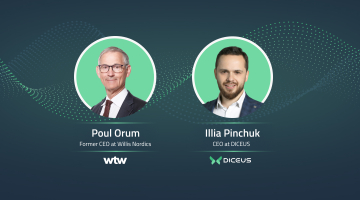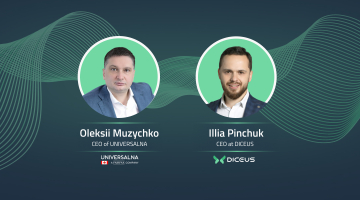
Interview with Chief Commercial Officer of Fadata: Implementing insurance process platform INSIS
Anders Holm recently joined Fadata as a Chief Commercial Officer (CCO) after spending 25 years in the financial services sector. Before that, Anders worked as a Managing Director at Temenos Nordics. With such a strong background, he is focused on establishing Fadata and its insurance process platform INSIS as a leading software solution for the insurance sector.
DICEUS is an official partner of Fadata for INSIS implementation, and Illia Pinchuk, the DICEUS CEO, talked to Anders. They had an exciting conversation covering the uniqueness, and interesting challenges of implementing INSIS, its configuration, competitive advantages, and many more valuable insights. Anders told our readers about the importance of digitalization and flexibility for insurers to grow and provide excellent customer experience.
By the way, Anders has a dream. One day, he would say, “All insurance companies with INSIS are saving X amounts of money in their basic operations compared to their peers. The more they use INSIS, the faster and better they run.” And we wish him this dream come true soon.

Q: Anders, a few insurance core platforms can support diverse lines of business. As I know, Fadata’s product INSIS can do that. In your opinion, why is a comprehensive solution so crucial for insurance businesses today?
A: Today, insurance is comprised of solutions few of which are corporate-wide. Most are supplied by in-house developments that are quite cumbersome, expensive to operate, and not very flexible. Thus, the insurance sector is looking into some tough years in its journey toward being digitalized.
At Fadata, we provide an out-of-the-box solution, easily and fast-implementable and integrable, based on standard components. The INSIS product is based on the same code base. It supports three distinct lines of business: life and pension, P&C, and health. So, you can either buy the whole package if you’re a composite insurer and get the full service of the operating engine or buy it as distinct components.
Q: What are the most significant competitive advantages of INSIS?
A: The most significant advantage of INSIS is its flexibility. It’s a very flexible and highly customizable package based on standard components. You’re staying on the same code base and can upgrade very quickly. So that’s the standard. Easy, deployable, and fast access from the investment to the value of money.
Q: Could you please give us a few examples of that flexibility?
A: Surely. Once you have configured the product with our Configurator, it will be accessible with all the characteristics across the other lines of business. The other example is that it’s based on one code base. So, it’s one solution you get and benefit from, having only one processing engine.
Q: And who can do this configuration? Is it a client, or should you do this?
A: We have two models. Firstly, we have a professional service consultancy that can customize according to the standard. Secondly, we have a very strong relationship with partners that can do the same together with us or independently. Of course, we require that the partners pass all our training and certifications. As long as it’s customizations on the standard package, you will not lose the opportunity to upgrade and migrate to newer versions. That means you get fast and easy access to upcoming modules, new functionality, and features.
Q: You already mentioned the business lines INSIS supports. Is it possible to buy it not for all business lines, but just what you need?
A: If an insurance company is only a P&C company, they will get access to the core base only plus the actual P&C side of things. However, if you are composite insurance, you’ll be able to enjoy the entire package on one code base.
Q: And how about the price? I mean, would a customer pay for one business line?
A: Of course, our customers pay for what they use. What they don’t use — they don’t pay. There are no hidden agendas here, and we deploy different commercial models with our customers.
Q: What are the biggest challenges of implementing INSIS and similar systems?
A: Dealing with and migrating away from the legacy. So, the implementation effort. It’s a lot of cultural change, and changing the business processes into a more digitalized nature is often challenging.
And, of course, integration. We offer INSIS as a standard solution with the application programming interfaces, which means that we provide that with the standard “plug and place.” Compare that to electrical sockets on the wall. We give the socket, and the customer provides the link so they can still work with their front ends and integrate into their portals, CRM, and finance systems. We supply the code and a standard gateway to communicate with the code.
Q: How much time does it take to implement INSIS?
A: It depends on what kind of process you want to implement and what you have today. I would say that if you have a completely green field with no migration in a simple P&C environment, install the products and just configure the vanilla out-of-the-box with no customizations; we could bring customers up and running in four to six months. And we aim to be faster. The more customers we can get on the platform, the better.
Q: What about your implementation approach? How do you work with customers?
A: We guide customers using our experienced implementation and functional consultants, business analysts, and architects. Then, we coach customers, often with partners with expertise in frontend and change management processes. We stick to what we do best and let the partners do the rest but with one overarching target, which is to get through the implementation as fast as possible so the value creation can start when you’re on the new platform. Of course, there are issues, delays, budget overruns, code defects, and different ways of understanding how the functionality should be executed. Of course, that happens, but our business analysts and consultants can tackle that. Along with consultants, we have a partner community that can help customers prepare for that journey.
Q: Which engagement models do you use with the customer? Is it Agile or Waterfall?
A: Our organization has moved towards Agile. It’s not the specific tool we use. That’s about solving the process pragmatically to get to the target as soon as possible. So, if that is a specific safe method like Agile Accelerator or just a plain Agile Master, we do that. If the customer is using Waterfall, we will adopt it. So, we are flexible in that context. Our implementation and development specialists adhere to Agile because that’s the fastest way to deploy new features with increments defined in backlog, optimized, and shorter sprints. The more releases we do, the faster we bring value to our customers.
Q: Anders, how do you work with partners? How do you engage them in implementation, and at what stage and level?
A: Our primary option is to get the customers live. If we go in with a partner, the customer will see that the partner and the software house are in sync. They have a standard model as they deploy the same tools similarly.
So, we work closely with our partners selling for us, trading with us, and operating with us. Sometimes, we use partners as subcontractors to extend our capabilities where we are short.
Q: Which added values do your clients get while implementing INSIS with Fadata or partners?
A: I would say it’s reduced operational costs. So, fast processing, less manual handling, a speedier way to value, and standardized user interfaces. Our customers get more digitalized, and that’s the complete transformation of the industry. We enable customers to execute policies in the market faster, with less hand-holding and straight-through processing.
Q: I heard you build a marketplace-like ecosystem around INSIS. What idea stands behind it, and what are the benefits?
A: Though we are ambitious, we are also knowledgeable enough to say that we cannot do everything for everybody. So, we want to focus on what we do best and then leave the rest to those who do their best. That means we will supply the core engine and the internal interface to the caseworkers and the insurance employees. For all of that outside, we would like to use value and ecosystem partners.
Q: And how about country layers? Do you see the need?
A: Absolutely. Country layers are a part of our strategy. In the future, the country layers will be put out basically in the same marketplace. It would be a product that you can buy as an add-on facilitated by the same API set that any other add-on product will be. This will be our extra contribution to the country layer, and maybe in the future, we will externalize that as we can’t do everything for everybody.
Q: INSIS has a service-oriented architecture that allows for connecting with other ecosystem solutions. How does it work?
A: Compare Fadata and INSIS to Tesla. What makes Tesla specific? It’s not the steering wheel or design; it’s the battery. When you design Tesla, you need to have a battery. So, if you compare the battery in this context to INSIS, you can configure which wheels you want.
So, we deliver the core value — the processing engine. The rest is released to the marketplace. Tesla also sells the whole value proposition. But they use partners from their network to deliver the whole solution. So do we.
Q: The customer experience starts when a person hears about the insurance company and ends when the claim is handled. Do you agree?
A: If you have everything on one platform or all the components collected in the same code base with APIs, your execution and process time is much smaller. That means your cost will be lower. You can also lower the price so the customer experience at the end of the day will be faster and more efficient. It should facilitate the fact that the policy price should be lower.
The same goes when you have a claim, when a car accident happens, or when you need medical care. The experience should be better, more integrated, seamless, and faster. You want to get help without talking to 10 people and signing many documents, but do it all online in real time. That’s the experience our processing engine gives to deliver that part of the value. Of course, we also need the ecosystem. And the partners provide their pieces of the puzzle.
Q: Thank you very much. Is there something else that you’d like to add?
A: Obviously, the work we’re doing with you. We are deploying with you because you are getting closer to our hearts. After all, you will be an integral part of our ecosystem. It’s about shaping the programs, delivering the programs, and also managing and operating them with your value-added assets together in our joint ecosystem.





